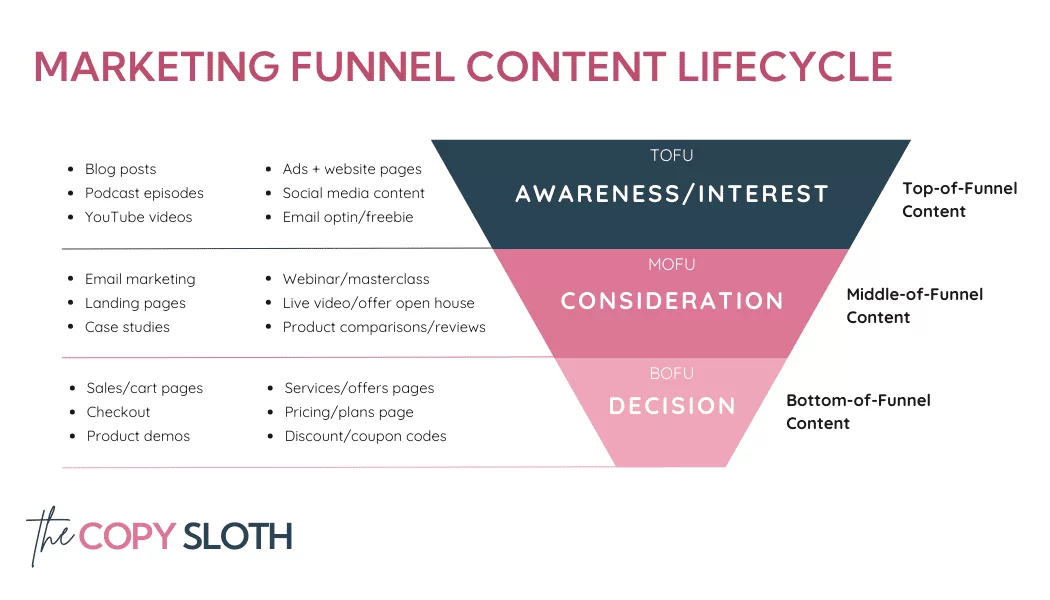This post may contain relevant affiliate links. These give me a small commission at no additional cost to you if you make purchases with them. Please see my disclaimers for more information.
When the allure of social media’s potential virality overshadows your list or newsletter, it’s easy to overlook the importance of email marketing. But what you might gain in terms of exposure on social, you sacrifice an overwhelming piece of your control.
On social media, you compete with other creators, might feel stuck in imposter syndrome, and may even slowly develop content fatigue. These platforms constantly want you to chase, chase, chase: the next new trend, the next new audio, etc.
This post isn’t to say that email marketing is better than other marketing avenues. Rather, I’m writing this one because I think others need some perspective straight from the source: an email copywriter. So let’s explore the question, “Why is email marketing important in 2023 and beyond?”

This post is all about understanding the importance of email marketing.
Table of Contents
Why is email marketing important?
Email marketing is important for small online business owners or solo entrepreneurs because it’s one of the most popular AND accessible ways to reach your customers. It’s also an omni-funnel marketing method that you can take advantage of throughout the entire marketing funnel lifecycle!
You shouldn’t overlook the importance of email marketing because it’s multi-functional and multipurpose. Target different people at all stages of your marketing funnel or customer journey.
- Top of funnel (TOFU) email marketing: Create a lead magnet and attract people to your website, offers, or business. ‘Onboard’ your leads with a tailored email sequence and transition them to your regular email list.
- Middle of funnel (MOFU) email marketing: Nurture your email subscribers by sending them a weekly email. Further segment your list by inviting them to click on interest or offer-based links. Reintegrate cold subscribers into your funnel.
- Bottom of funnel (BOFU) email marketing: Send segments of your list relevant launch, offer, or product emails. Invite targeted subscribers to join you on a webinar or live video that you create.

Let’s briefly shift over to accessibility in email marketing for a sec. While you could argue the same for social media, I think email marketing offers an abundance of growth opportunities. Anyone can grow and promote their list (and raise awareness for their business) through a number of different ways:
- Creating a lead magnet
- Writing blog posts that will eventually rank on Google or Pinterest
- Promoting a valuable webinar or workshop
- Joining a bundle with someone in your network
- Running an ad on Google or social media for a free lead magnet or a low-ticket course
- Posting informative, relevant videos on YouTube
- Paying for a spot on promotional newsletters like I Love Creatives
- Speaking on podcasts or YouTube channels as a guest
- Building a sales funnel
^ All but one of these DON’T involve social media whatsoever. (Learn all about why Pinterest isn’t a social media platform from an expert Pinterest Manager, Heather Farris.)
On social media, we’re at the algorithm’s mercy to get seen — not to mention the fact that we’ve all been trained to scroll, scroll, scroll. On ads, we have to spend a pretty penny to find the best leads.
On email marketing tools like Convertkit, you get to segment through the not-so-relevant subscribers and speak directly to the people you want to reach for your intended purpose: selling, nurturing, offboarding, etc.
Reason 1: Reaches a larger audience
According to Hubspot, there are 4 billion daily email users globally. But that’s really too macro for my taste. So let’s break down the numbers a bit more. First, by generations!
Across each of the four oldest generations today, a study on Statista found that an average of 70% of people prefer hearing from brands via email. To help paint a clearer picture for you, here’s the generational breakdown:
- 57% of Gen Z prefer email contact from brands
- 79% of Millennials prefer email contact from brands
- 67% of Gen X prefer email contact from brands
- 69% of Baby Boomers prefer email contact from brands

I know this section is a bit numbers heavy, but I think it’s super important to fully understand how to objectively see how email marketing can serve your business (or any platform really). Here are a few other fascinating facts that highlight the importance of email marketing:
- Out of those 4 billion email users, 99% of consumers check their email every single day.
- 59% of Millennials use their smartphones to check email.
- 67% of Gen Zs scan their inbox using their phones.
- And here’s the kicker: Folks with smartphones prefer brand updates through email.
The conclusion is clear: if you want your brand updates to land in front of your consumers and actually get read, email marketing is the best route. Which reminds me…
Reason 2: Messages will actually reach subscribers
With email marketing, you’ve got a direct line to all of your subscribers. When you hit send, you know it’s reaching their inboxes (unless you’ve done things that land you in the spam folder or affect your email deliverability).
The song and dance is rather predictable: a subscriber opens your email, they read it, and (if your words strike a chord) then they take action. The only way out for an email subscriber is that unsubscribe button (which we love around here).
When it comes to email marketing, there’s really no algorithm forcing you to compete for your subscriber’s attention/room in the feed (other than the other emails in their inbox). Even then, you have two insanely powerful tools you can use to ensure you get higher open rates: a killer email subject line and/or strong brand awareness.
MARGIN NOTE: If you’re brand new or starting an email list from scratch, choosing an email service provider that allows you to A/B test your subject lines for each email broadcast you send out like Convertkit can give you an edge!
All of this to say that my eyeballs twitch anytime I hear anyone say social media is definitively better than email marketing. Here’s the catch with social – you don’t have full control over how many of your followers actually see your message.
To give you an idea of all of this information in action, I want to show you where I’m currently at for the past 90 days as well as for my latest campaign:

No…those unsubscribers don’t count toward my click rate. I’m planning an epic blog post (and possibly a YouTube video) all about why I love unsubscribes as an email copywriter, so be on the lookout for that a little later next month!
Moving on! If you believe you’ll ever see numbers like those on your social media analytics, call me Bearer because I have some bad news. Organic reach is, well…not what it used to be.
According to a SocialInsider.io study, there’s a HUGE drop of both reach and engagement on the two bigger platforms in 2023. Check out these organic reach stats including TikTok:
- Facebook: 1.90%
- Instagram: 4.20%
- TikTok: 5.15% (per video average for business accounts according to Metricool)
A separate study on TikTok engagement rates conducted by both Metricool and Statista and published back in March 2023 shows a general engagement rate by video length. There’s a slight correlation between video length and engagement. Videos that exceed 54 seconds in length have the highest engagement rate (at least in this study).
Either way, you’ll see that tiktok has a higher engagement rate than the likes of Instagram and Facebook. (Do you feel Meta quaking in their boots yet?)
While TikTok isn’t as old as the other players in this space, it’s quickly become the golden child standard of traffic, attention, and e-commerce awareness. Even Google has its eyes on the platform. That being said, a Metricool and Statista study found that engagement isn’t nearly as static as Instagram and Facebook. There’s a clear correlation between video length and higher engagement.

What is organic reach?
In the marketing world, reach is an awareness metric. It’s a metric that indicates exactly how many users, accounts, or subscribers see your posts, emails, and/or content. Every creator, entrepreneur, or online business owner (whatever you call yourself), has two options to grow their reach: organic or paid reach.
- Organic reach is a method that relies on something to push out the content you post. The easiest example of this is when you post a TikTok and it lands on users’ for you pages.
- Paid reach is a method that relies on you (or your company) to pay to get in social media feeds or Google search pages (SERPs).
For most solopreneurs and small business owners, ads aren’t usually viable: either because of a lack of funding or a lack of optimization knowledge.
Reason 3: It’s Cost-Effective
Email marketing is probably the most cost-effective marketing method in both time and money. Service providers that offer all the bells and whistles like Convertkit usually have free trials (albeit limited on features) for up to 1,000 subscribers. If you’re all in and ready to pay, you could also consider Flodesk ($19/month for the first year) if you want a more simple, aesthetic experience.
Compared to running ads or sinking a ton of time into figuring out your social media strategy, email marketing costs pennies and minutes to get up and running.
You’re probably data’d out by now, but stick with me! Email marketing isn’t just a low-ticket tool to your subscribers’ inboxes. It’s also infamous for yielding a strong return on your investment, too!
- A 2023 study by LyfeMarketing.com shows that for every $1 that goes out of your pocket, the average return on investment (ROI) is 122%.
- Litmus cites that for every $1 spent, you can usually expect to get $36 back in ROI.
Ready to make your marketing budget go the extra mile? Investing in email marketing can be a golden opportunity for you and your business. For a lot of businesses out there with cost on the brain, this reason clearly explains the importance of email marketing so damn well!
Reason 4: Easy to measure and track subscriber behavior
Delivering emails to your audience is only half the fun of email marketing! Most tools can also help you to monitor your subscribers’ interactions/behavior: tracking email open rates, click-through rates, bounce rates, engagement rates (or a lack thereof), and even unsubscribe rates.
Subscriber behavior is arguably the most important metric in email marketing. At least…I’d argue that! Not only does tracking these interactions help you better understand your subscribers. Doing so helps you to:
- Gauge and audit your own email content, subject lines, etc.
- Refine your strategies and focus on what resonates best with your audience
- Automate sequences that help to maintain positive email list hygiene
Reason 5: Learn what works and what doesn’t
Knowing what’s working and not working is the perfect way for you to pivot, edit, or slightly alter your email marketing strategy. Every metric your email service provider (ESP) allows you to see can help you convert better as you continue to grow your list.
I fully believe in intentionally experimenting with an email list — incrementally testing ONE SINGLE thing at a time so you can learn if that’s indeed the problem or not converting well.
- The reason why your emails might never have a high conversion rate or clickthrough rate might be because you don’t have strong calls-to-action (CTAs).
- You might not be including the main link you’re promoting enough times throughout the email’s content.
- Your email subject lines might suck or you’re not A/B testing them before you send the email to your whole list.
- You might be missing out on more opens and clicks by not resending the email to the subscribers who haven’t opened up the original.
- Your email sequence may not onboard or guide your subscribers in a clear enough way. Alternatively, you might not even include an ‘about me’ style email in your welcome sequence at all!
Run A/B tests
If your ESP allows it, run an A/B subject line test to give you the best chance at success. You might add some emojis for flair in one version and keep the other more laid-back. The one with the higher click-through or conversion rate is the winner. A/B testing is honestly the reason I haven’t switched from Convertkit to Flodesk if I’m honest.
MARGIN NOTE: Did you know that people are 56% more likely to open your emails when you include an emoji in the subject line? Take a look at Nethunt’s data to learn more!
Collect feedback and surveys
In the age of AI and ChatGPT, leaning too much on what data your email service provider (ESP) gives you might eventually feel too impersonal. That’s why I LOVE surveying my list for feedback! Directly asking your audience is such a goldmine. You can create a formal form or simply ask your subscribers to answer a question or few by replying to your email.
- Ask them what they would love to hear more about.
- Challenge them to open up about what’s not working for them.
- Gauge their opinions about an offer you’re thinking about.
Reason 6: You can personalize your email content
Personalization continues to be a HUGE email marketing trend that’s becoming more of a standard practice. One thing to know about personalization is that it’s so much more than a first name at the beginning of your email.
You can use personalization to send emails based on certain known topics, past buying decisions, link engagement, and so much more! Here are some emails and sequences you can send, automate, or personalize:
- Welcome sequences: Your welcome sequence can be the perfect place to begin segmenting your list. If you have a few lead magnets, you can include an email that invites them to click on the general freebie’s topic so you get to know what they want or where they’re at.
- Abandoned cart emails: A friendly reminder for those items they left behind, waiting for them. Always remember that a lack of action (buying) is an action!
- Exclusive offers: Special deals for those who’ve shown extra love to your brand — be it first-timers or loyal customers. You can also segment OUT people who may have already purchased your offer.
If you’re a multi-passionate entrepreneur like me, segmenting your audience is non-negotiable! When you correctly implement the right segmentation strategy, you’ll be able to organize your subscribers based on interests, purchases, behaviors, etc.
Reason 7: Increases brand awareness
Driving revenue/profit into your business is only one half of what email marketing can do for your business. Any business (especially those with a very small following/online presence) can benefit from nurturing potential customers in the inbox.
Say what you will about social media and TikTok, but email marketing has a one-up that can’t be denied: no limits. Where you might be restricted to 60 seconds on your YouTube short or Instagram reel, emails give small business owners the freedom to explore content in any length they want or need.
But don’t think that every single email you send has to be an in-depth blog post. I don’t personally know anyone who would read a 3,000-word email. Would you? Probably not. But in email marketing, you’re able to link directly to other resources, offers/products, trainings, and so much more.
That means that when you’re not seeing the engagement or results you want on social media, you can send out a broadcast promoting whatever you’re looking to blast out to your people.
Email is also the go-to channel for brand updates. It’s a direct line to your audience, where you can share promos, product news, and engaging newsletters. Plus, it’s an easy bridge to your social media or website.
What are 5 advantages to using email marketing?
Email marketing has these five advantages to small businesses, creators, and service providers:
- Cost-Effectiveness and High ROI: It’s budget-friendly with impressive returns.
- Full Reach: You get direct access to 100% of your subscribers.
- Audience Insights and Effective Campaigns: It aids in gathering crucial insights for successful marketing campaigns.
- Hyper-Personalization: Tailored emails resonate more with subscribers.
- Enhanced Brand Awareness: It strengthens brand recognition.
Don’t think that these are the only advantages email marketing offers! But in terms of what I consider the best of the best, they definitely are among my top choices that you should know about. These five advantages really summarize the importance of email marketing.
Why email marketing is more important than ever?
The importance of email marketing roots itself in one thing: ownership. Unlike social media, you fully own your email list. You’re not at the mercy of a random, ambiguous algorithm. With an intentional, segmented email list, you can choose exactly who you want to speak to.
Given the strong, proven presence of email in the daily lives of Millennials as well as Gen X and a significant portion of Gen Z, email marketing will continue to be a pivotal fixture in the marketing landscape. If you’re looking for a long-term strategy for your business, email marketing is your steadfast ally.
Email Marketing vs Social Media
For introverted entrepreneurs like me (and maybe even you), email marketing doesn’t require me to post every single day, doesn’t need me to engage with others to grow, and doesn’t really need much optimization right out of the gate.
Unlike platforms like TikTok, Twitter/X, or Instagram:
- It’s easier to speak to ONE SINGLE person
- You’re in complete control of your list
- You don’t have to worry about too many aesthetics (unless you’re in e-commerce)
- You can show up without feeling self-conscious about what you’re wearing or your hairstyle
Wrap-Up: The Importance of Email Marketing
Even with the pros and cons laid out in this post, email marketing remains a reliable, sustainable, cost-effective, and easily accessible marketing tool. Despite the rise of AI and other email marketing trends, email marketing proves its resilience, riding the waves of change. I see it as poised to flourish in the years ahead.
This post was all about the importance of email marketing.



